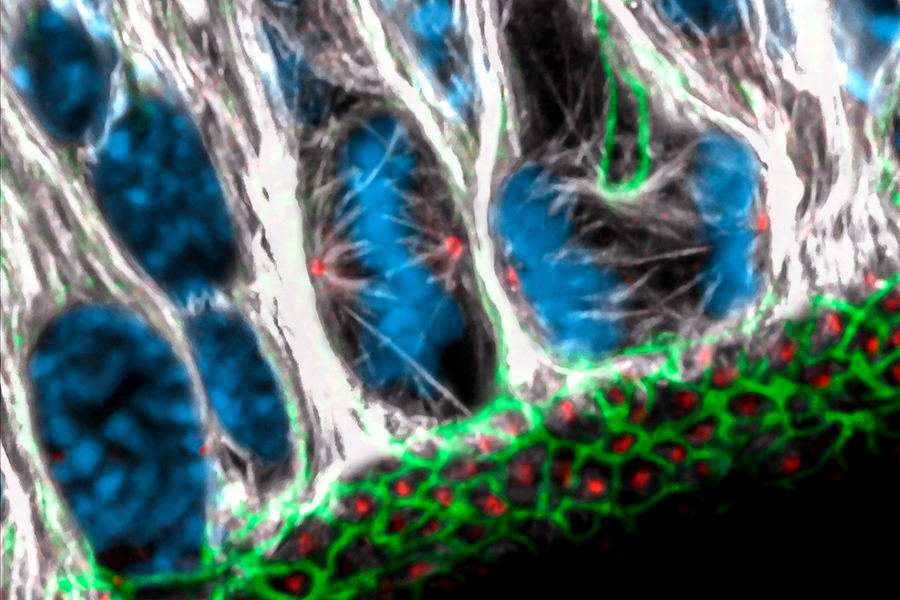
Neural stem cells dividing in the embryonic mouse neocortex. The white rods in the metaphase cell in the centre of the image are mitotic microtubules. An example of an apical astral microtubule is the long white rod extending from the left spindle pole (red) to the apical cell membrane (green). Such apical (and also basal) astral microtubules promote symmetric divisions that split the cell perpendicular to the ventricular surface, as shown in the anaphase cell to the right of the metaphase cell. Chromosomes are in blue, centrosomes are in red.
For our brain to grow and develop healthily, neural stem cells have to first multiply and later start producing neurons, which are needed for the brain to function. Researchers at the Max Planck Institute of Molecular Cell Biology and Genetics in Dresden (MPI-CBG) now report in the journal eLife how neural stem cells in the developing neocortex control the switch from cell divisions that multiply stem cells to divisions that produce neurons. They identified a certain type of cellular ropes that controls the orientation of the cell division machine and, therefore, the type of division. This study sheds new light on how cell division is controlled to influence brain development.
During the development of the mammalian brain, neural stem cells multiply by dividing symmetrically into two new stem cells. Later, they switch to asymmetric division, where one stem cell and one neuron are produced. Inside dividing cells, the mitotic spindle, a multi-molecular machine, partitions cell components to the new daughter cells. For symmetric neural stem cell divisions, the spindle is oriented to divide cells vertically, that is, from their bottom to their top. For asymmetric divisions, the orientation changes and some components are partitioned unequally. This helps the daughter cells to specialize, for example into neurons.
Spindle orientation is controlled by astral microtubules – cellular ropes that connect the spindle to the cell membrane. Classical studies on neural stem cells in invertebrates have shown that, for an asymmetric division, the spindle is fully reoriented by 90° to divide the cell horizontally. “However, in mammals, most reorientations are much more subtle”, says Felipe Mora-Bermúdez, who conducted the experiments in Wieland Huttner's lab. “We knew spindles behaved differently in mammals, but we didn’t have a clue how they did it”.
To find that out, they used powerful microscopes to analyze divisions of neural stem cells in the developing mouse neocortex, and which are similar to those in humans. Contrary to previous assumptions, they saw that not all astral microtubules were responsible for controlling spindle orientation but only those connecting the spindle to the top (apical) and basal (basal) of the cell membrane. When a cell will undergo symmetric division, many of those apical and basal astrals anchor the spindle to the cell membrane, ensuring a stable orientation for vertical division. “It’s like building your camping tent”, compares Mora-Bermúdez: “For a stable tent you anchor it with many guy ropes. Analogously, for neural stem cells to divide symmetrically, their spindles need to be strongly ‘roped’ ”.
To switch to asymmetric divisions, the number of apical and basal astrals is decreased. The spindle becomes less anchored and can tilt more freely, which triggers a division that is a little off-vertical and results in neuron production. “The control of this switch is crucial”, says Wieland Huttner, Director at the MPI-CBG who supervised the project. “Mistakes can lead to neurodevelopmental disorders that result in very small brains and mental retardation, for example microcephaly and lissencephaly”.
This study offers a new perspective on neocortical neurogenesis. It reveals novel links between cell polarity and the symmetry of neural stem cell division in health and disease, but also as part of the evolutionary changes that lead to different brain sizes among mammals.
Mora-Bermúdez, Felipe; Matsuzaki, Fumio; Huttner, Wieland B.
Specific polar subpopulations of astral microtubules control spindle orientation and symmetric neural stem cell division.
eLife 2014, doi: 10.7554/eLife.02875